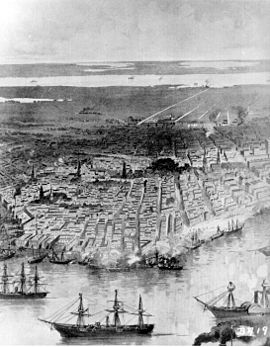This article has multiple issues. Please help improve it or discuss these issues on the talk page. (Learn how and when to remove these messages)
|
| Capture of New Orleans | |||||||
|---|---|---|---|---|---|---|---|
| Part of the American Civil War | |||||||
 Panoramic view of New Orleans; federal fleet at anchor in the river (c. 1862) | |||||||
| |||||||
| Belligerents | |||||||
|
|
| ||||||
| Commanders and leaders | |||||||
|
David Farragut Benjamin Butler | Mansfield Lovell | ||||||
| Units involved | |||||||
|
Department of the Gulf West Gulf Blockading Squadron | Department No. 1 | ||||||
| Casualties and losses | |||||||
| None | None | ||||||


The capture of New Orleans (April 25 – May 1, 1862) during the American Civil War was a turning point in the war that precipitated the capture of the Mississippi River. Having fought past Forts Jackson and St. Philip, the Union was unopposed in its capture of the city itself.
Many residents resented the controversial and confrontational administration of the city by its U.S. Army military governor. This capture of the largest Confederate city was a major turning point and an event of international importance. It also caught many Confederate generals by surprise who had planned for an attack from the north instead of from the Gulf of Mexico.[3]
- ^ Official records of the Union and Confederate Navies in the War of the Rebellion. I, v. 18, p. 131.
- ^ Atlas to accompany the official records of the Union and Confederate armies. Plate XC.
- ^ "Union captures New Orleans". www.History.com. Retrieved October 27, 2022.